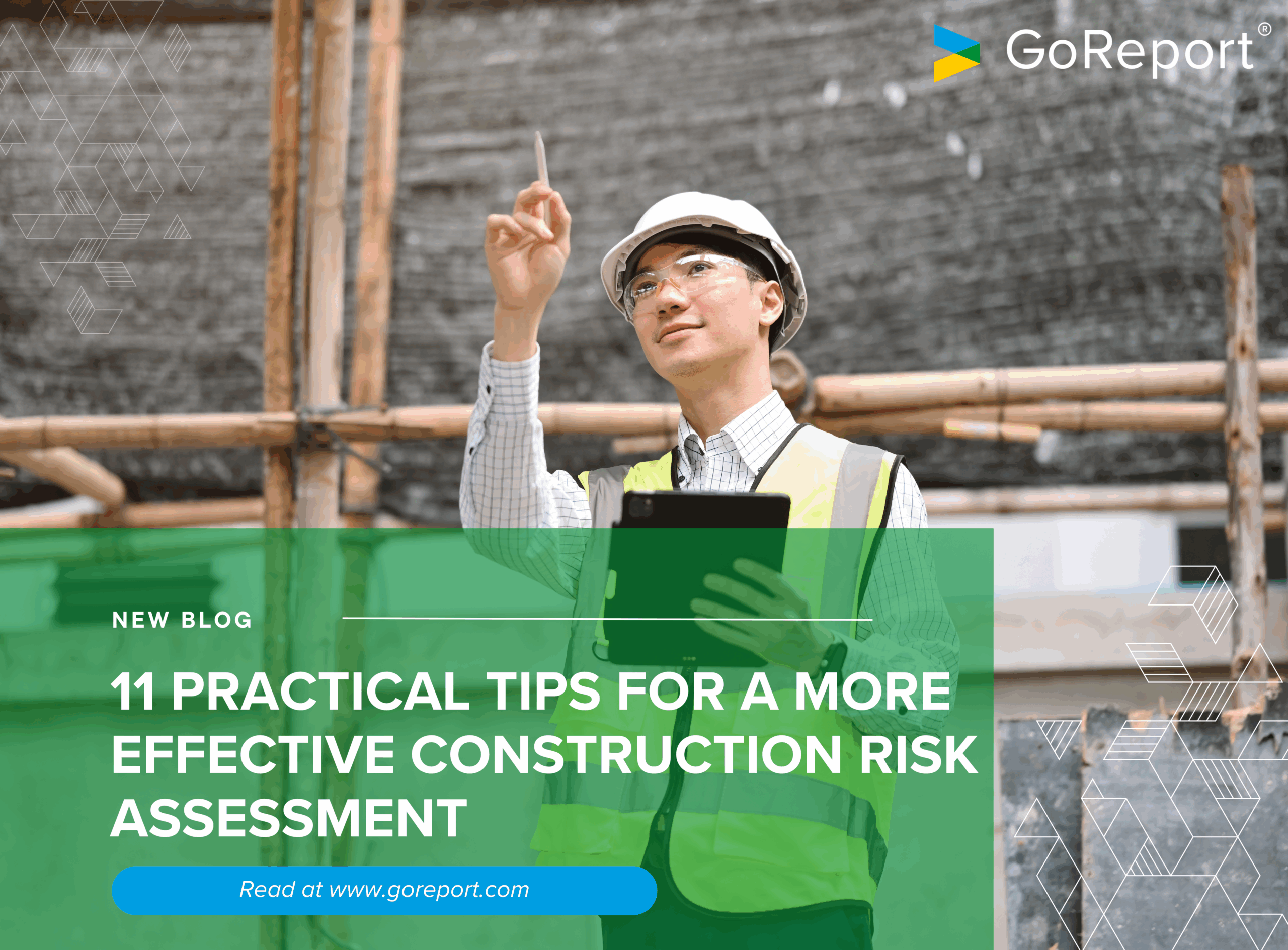11 Practical Tips for a More Effective Construction Risk Assessment

If you’ve ever walked a live construction site, clipboard in hand, trying to juggle hazards, timelines, and stakeholder expectations (all before your second cup of coffee), you already know this: construction risk assessments are the backbone of safe, efficient, and compliant sites.
Yet, despite all the regulation and guidance, some assessments still fall short. Now, this isn’t because surveyors don’t know what they’re doing, but rather the processes in place haven’t kept pace with the tools, data, and expectations now available.
So, let’s fix that.
This guide brings together 11 smart tips to help commercial surveyors carry out risk assessments that are not only compliant but credible, efficient, and built for today’s challenges.
What is a Risk Assessment in Construction?
At its core, a construction risk assessment is a systematic process of identifying hazards on a construction site, evaluating the likelihood and consequences of each, and putting controls in place to reduce the risk.
That’s the technical answer, but in real terms, a solid risk assessment does more than tick regulatory boxes. It aims to protect lives, avoid costly delays, and reassure your client that they’ve hired the right professional. When done well, it becomes a key part of project success, not just a safety form buried in a filing cabinet.
So how do you move beyond the basics? Consider integrating the below tips into your workflows.
1. Understand the Legal Landscape First
If your assessment doesn’t meet the minimum legal requirements, it doesn’t matter how thorough or well-written it is.
In the UK, you’re expected to comply with:
- The Health and Safety at Work etc. Act 1974
- The Management of Health and Safety at Work Regulations 1999
- CDM (Construction Design and Management) Regulations 2015
And if you’re working in Ireland? You’re looking at the Safety, Health and Welfare at Work (Construction) Regulations 2013, among others.
Always start with these. Bookmark the legislation. Cross-reference your approach. Better yet, build them into your surveying tools and templates from the start so that compliance becomes routine, not rushed.
2. Involve the Right People Early
Risk assessment isn’t a one-person job. You might be leading the process, but input from the site manager, contractors, safety reps and even nearby businesses or tenants can uncover hazards you won’t see on paper.
Start by involving:
- Site supervisors or project leads
- Health and safety coordinators
- Workers on the ground (they know where the shortcuts happen)
- External specialists, where needed
Yes, it takes more time upfront, but it saves much more down the line when blind spots are caught early.
3. Identify Risks Like a Story, Not a Checklist
If you treat risk identification like a box-ticking exercise, you’ll miss context. Instead, take the time to ask “what’s happening here, who’s doing it, and what could go wrong?”
For example:
- Don’t write: Scaffolding hazard identified.
- Do write: Scaffolding erected near pedestrian walkway; risk of falling tools during windy conditions when materials are lifted overhead.
This paints a clearer picture and helps others less qualified understand why it actually matters in a real-world context.
4. Use Clear, Site-Specific Descriptions
Generic wording might feel safe, but it weakens your report. Vague risks are easy to ignore. Site-specific detail is what sets good assessments apart.
Avoid phrases like:
- “May cause injury”
- “General trip hazard”
- “Use caution”
Instead, say exactly what, where, and why. If there’s a trip hazard on the east corridor where steel beams are being delivered daily, say so. That level of detail builds trust and triggers better follow-up actions.
5. Quantify Risks Without Guesswork
The classic risk matrix (likelihood × severity) is useful, but only if it’s applied consistently.
Here’s a simple trick: anchor each score with real-world benchmarks.
For example:
- Likelihood 3 = “Has occurred once this month on site or nearby”
- Severity 4 = “Would cause hospitalisation or project-wide delay”
That way, you’re not just scoring on gut feel, you’re giving measurable context that others can interpret and act on.
6. Make Use of Digital Tools (Yes, Really)
Still scribbling notes and typing up later? That’s not efficient and it introduces risk in itself. Lost notes, transcription errors, and missing evidence can all compromise your assessment.
Modern tools let you:
- Capture photos and notes directly on-site
- Tag hazards by location
- Use templates that adapt to your project type
- Generate reports instantly, no retyping needed
Surveyors using digital reporting tools report massive time savings, especially when handling multiple sites. And if you’re worried about AI, tech and compliance? Here’s how to handle that.
7. Track Changes Over Time, Not Just Once
Construction sites change fast. A risk assessment from three weeks ago may no longer reflect site reality. So what do you do?
- Build in regular reviews, weekly or after major changes
- Keep version control to show what’s been updated
- Use tools that let you compare previous versions side-by-side
This not only keeps you compliant, it also gives you stronger protection if issues arise later. You can demonstrate due diligence and adaptation over time.
8. Don’t Overlook Human Factors
Surveyors aren’t robots. Even with the best PPE and signage, fatigue, shortcuts, or miscommunication can cause accidents.
Consider:
- How long workers have been on shift
- If language barriers exist
- Whether workers feel safe reporting hazards
Sometimes the biggest risks aren’t technical, they’re cultural. Acknowledging that in your report can go a long way in building better safety habits on site.
9. Document with Purpose, Not Just for Compliance
Too often, documentation becomes about covering your back, but the real value of a well-written construction risk assessment is that others actually use it.
Make sure your report:
- Is clearly structured (defined sections, not walls of text)
- Highlights urgent risks in bold or coloured sections
- Includes photos or diagrams where relevant
- Uses plain language alongside technical terms
Need inspiration on how to write stronger reports? Here’s a guide on documentation that actually works.
10. Include Recommendations That Are Actually Actionable
You’d be surprised how many assessments end with: “Contractor to monitor situation.” That’s not a plan.
Good recommendations:
- Name who is responsible
- Include a timeline
- Reference specific guidance or controls
- Are written in clear, direct language
For example:
“Site foreman to install edge protection by 12 August, per HSE guidelines for working at height.”
See the difference?
11. Review and Reflect After Every Assessment
Construction projects rarely follow a straight line. That’s why post-assessment reflection is so valuable.
Ask:
- Were the controls implemented?
- Did they work?
- Did new risks emerge as a result?
Build this into your own workflow, and it becomes second nature. It also improves your future reports because you’re learning from every site, not just reacting to it.
If you’re still spending hours on back-office admin or trying to keep up with site changes using outdated templates, it might be time for a smarter solution.
Book a free demo with GoReport and see how surveyors across the UK and Ireland are saving time, staying compliant, and producing reports that clients actually value.
FAQs About Construction Risk Assessments
Q: What is the purpose of a construction risk assessment?
A: To identify hazards, assess their impact, and implement measures to reduce harm, keeping workers, the public, and the project safe.
Q: How often should a risk assessment be updated?
A: As often as site conditions change, and ideally reviewed at regular intervals (weekly or after major changes).
Q: Who is responsible for carrying out the risk assessment?
A: Typically the Principal Contractor or Site Manager, but surveyors and health and safety consultants often play a key role in structuring and validating the process.
Q: Can I do a construction risk assessment on paper?
A: You can, but digital tools provide faster, more accurate, and more compliant options. They also help with evidence collection and version control.
Q: What’s the difference between a hazard and a risk? A: A hazard is something with potential to cause harm (e.g. exposed wiring); risk is the likelihood that harm will occur, and how severe it would be.








